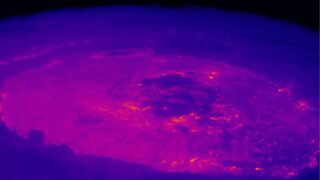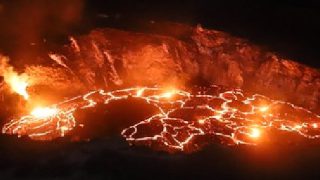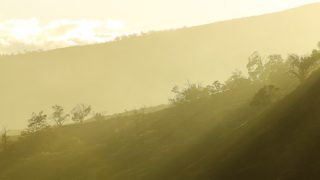One side-effect of the new eruption at Kilauea volcano and its lava flow that we conveniently forgot about struck silently yet painfully again this week. It was the worst air quality here at the other end of the Hawaiian Islands than we have seen in many years.
For those with respiratory conditions and asthma, it has been bad. What you see in the photo above is heavy vog concentrations over Kauai, reducing the sunlight and transforming the mountains into silhouettes. Vog was previously a severe problem in Hawaii, but that hasn’t been the case for years, so we somehow hoped it was behind us. Not so on any given day, depending on the wind direction and the degree of volcanic fog.
This week’s reoccurrence proved that the vog isn’t gone.
Vog airborne emissions impact visitors and residents and take on the appearance and effects of something akin to Southern California smog. The Hawaii Department of Health monitors the vog and its health effects, which can be especially harmful to those with medical conditions like bronchitis, emphysema or cardiovascular disease, for example, older adults, expectant mothers, and other sensitive groups.
The allergens burn the eyes, results in a sore throat and slight hacking cough, and causes congestion, among other symptoms. Vog exposure is less harmful to healthy people, albeit still irritating. It makes strenuous activities that much harder.
Mauna Loa vog, from Island of Hawai`i, traveled as far as Kauai this week.
Vog did get in our eyes this week and resulted in a foul odor and irritating symptoms. This week’s weather conditions have resulted in air that has been heavy, with light winds from the south, bringing the Big Island’s vog levels throughout the entire State of Hawaii, even as far as 250 miles away from Kilauea and its new lava lake and source vent.
We’re still anticipating a return of Hawaii trade wind conditions after another absence. That should help push the vog away from us and reduce the high levels of vog.
Hawaii’s volcanic smog, or “vog.” What is it?
It is a unique type of air pollution caused by a mix of sulfur dioxide and other gas volcanic emissions from the Big Island’s volcanos, in this case, Kilauea.
VOG peaked in 2008 and has subsided to very little, with occasional outbursts ever since. But then there was the brief Mauna Loa eruption at the Halemaʻumaʻu crater, and now Kilauea again, vog’s latest sources.
At the same time, Hawaii tradewinds continue to diminish generally, which means yet more changes for vog to sneak up the chain as long as it is belching from the Big Island. UH scientists have observed a distinct decrease in Hawaii’s trade winds over the past 40 years.
Hawaii interagency vog information dashboard.
The Hawaii Interagency Vog Information Dashboard provides comprehensive data and more information regarding vog and its impacts on Hawaii. Their last news was when Kilauea started erupting on January 5, when they said that “airborne emissions will produce some vog downwind.” So true.
Vog and your health.
Vog is bad for animals and plants alike. The pollutants impair respiratory function and are acidic in nature. Vog irritates the eyes, nose, and throat and can even result in headaches for some. Vog is considered worse for children’s health and for others with any type of respiratory issues. The long-term effects of Vog are being studied but, at this time, remain unknown.
The University of Hawaii has been at the forefront of vog research for the past two decades. The American Lung Association at one point ranked the Big Island as failing in its grade for air quality.
Hawaii trade winds.
Trade winds in Hawaii, our air condition and weather regulator, are in effect most of the time. They are, in part, what makes Hawaii weather unique and wonderful.
Trade winds were so named from the time when cargo ships relied upon them for fast movement. We often think of them as emanating from Alaska because of their cool and generally dry nature.
What are Kona conditions?
When the trade winds are absent, the wind will generally blow from the south, or there may be no wind. These are referred to as Kona conditions. These may occur at any time, and they are also present during stormy winter weather.
When Kilauea volcano began erupting in 1983.
At that time, Kona conditions brought vog up the entire island chain as far as Kauai. That has occurred upon increased eruption activity ever since. Vog makes the visibility very poor, causing eye and respiratory irritation for everyone here. Vog is very smog-like, just with another name and source. This week, we’ve again seen some of the worst vog in recent times.
VOG and your Hawaii vacation?
Do check the vog Dashboard for the latest updates, especially for those with respiratory problems. If you close windows and turn on air conditioning, it may be of help but generally won’t filter out vog’s harmful gases. Setting the air conditioner unit to “air recirculation” or “closed vent” can prevent outdoor air from entering your vacation rental or hotel room. An air purifier may also help. We find drinking plenty of water helps too.







Well, let’s sue the volcano and pele both. Sorry, it just seems that people don’t understand that with the beautiful exciting view, you get vog.
You surely have that nasty stuff about VOG correct! We were on Maui about a month ago and the VOG in Kihei was horrible, you could cut it with a knife. Yes there was little in the way of trade wind. With maybe the exception of Kauai the VOG had the islands covered. When we have stayed up at Waikola Village in the past, the VOG on the Big Island wasn’t much uglier.
Vog has never left. I’ve been here since 2006 and it has always been around. It does not bother me but people with breathing conditions will not want to spend hard earned dollars here.
I live on Hualalai above the airport. I am at the 800 foot level. Some days I can’t see the ocean horizon. Other days Hualalai can’t be seen and I live on the mountain.
Cheers gentleman
Hi Kelly.
You’re much closer to the source, so even a tiny amount may be more impactful there. But up here, 250 miles away, it has for the most part, been gone for years. Until these eruptions.
Aloha.
I’m older with pollen allergies & asthma, and I definitely noticed the vog on Kauai wafting over from the Big Island eruptions recently! It was so bad, I even resorted to wearing a mask (w a PM2.5 filter) indoors one day last week. I have an old house, and the windows don’t seal very well lol.